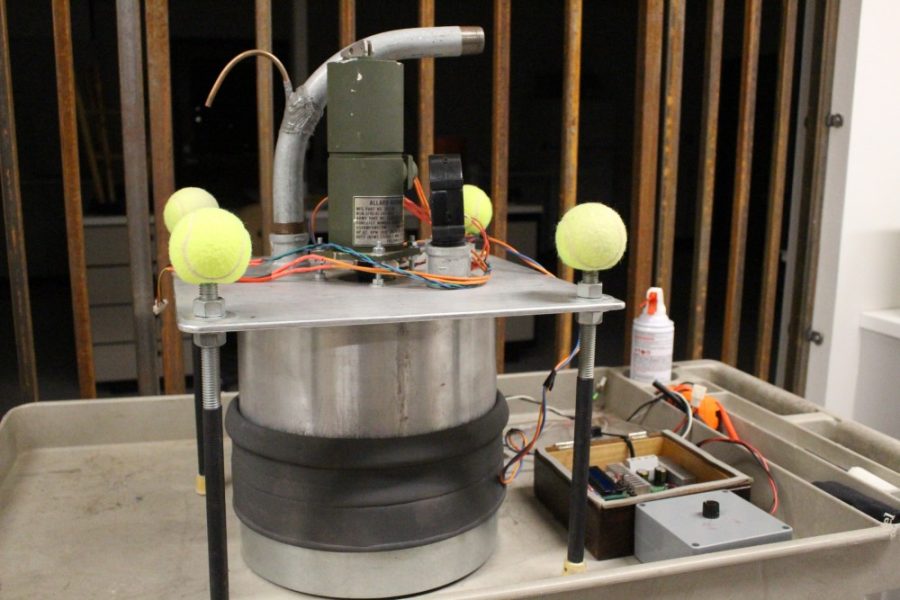Dust storms are common during summers in southern Arizona. They are a dangerous natural occurrence that, according to the World Meteorological Organization, happen “when strong winds lift large amounts of sand and dust from bare, dry soils into the atmosphere.”
Although dust storms happen often in southern Arizona and all around the world, they are unpredictable. But research being done in the Department of Hydrology and Atmospheric Sciences at the University of Arizona could be key in cracking the unpredictability of dust storms.
Ruby O’Brien-Metzger, a mechanical engineering major, is part of a team that is using a unique tool to calculate the wind speeds where dust begins to pick up.
“We call it the portable dust generator,” O’Brien-Metzger said. “The main component kind of looks like a big kitchen pot but it is upside down and the bottom part is open. The open part is placed on the soil, and an annular ring acts as a fan inside of the chamber and it blows a known wind speed onto the surface of the soil.”
RELATED: Q&A: Space round table to bring new topics to campus
O’Brien-Metzger said the portable dust generator then creates a miniature dust storm.
“There is also a sampling outlet that connects to a DustTrak, which monitors the dust concentration inside of the chamber,” O’Brien-Metzger said. “With those two main pieces, the known wind speed and the known dust concentration, we can see which wind speeds produce dust.”
The device O’Brien-Metzger and her team use in their research was designed right here at the UA. Its design was based off the Desert Research Institute’s PI-SWIRL machine.
Another factor of dust storms that O’Brien-Metzger and her team are researching is humidity.
“When an area has higher humidity, it has a higher soil moisture,” O’Brien-Metzger said. “Areas with higher humidity take higher wind speeds to produce dust.”
O’Brien-Metzger and her team have tested the soil in different parts of Tucson and the surrounding area. Their biggest test subject has been Picacho Peak area and the adjacent section of I-10. They’ve found that soil that has been disturbed requires a lot less wind speed to pick up into the air than undisturbed soil does.
Of all the areas they’ve studied, O’Brien-Metzger says that she and her team have concluded that the Picacho Peak area is more likely to generate dust storms than others.
“The soil [in the Picacho Peak area] is really loose due to a lot of agriculture and a lot of agricultural fields that have been abandoned,” O’Brien-Metzger said. “The soil is barren and unhealthy and it takes very little wind to create dust.”
With their research, O’Brien-Metzger and her team hope to solve the puzzle of dust storms and make the roads safer.
Dust storms are notoriously dangerous to be caught in while driving. According to the Arizona Department of Transportation’s 2017 Annual Crash Facts Report, 83 collisions were reported to have happened during a dust storm.
Doug Pacey, a spokesman for ADOT, says that the number one danger of driving in a dust storm is visibility.
“Visibility can drop to zero very quickly,” Pacey said. “It can be pitch black and you could be driving as if you’re blind.”
Pacey advises drivers that if they come across a dust storm while driving, they should avoid driving into the dust channel as best as they can. If drivers cannot avoid it, Pacey says the safest thing to do is: “Pull Aside, Stay Alive.”
“Pull Aside, Stay Alive” is ADOT’s official slogan for what to do if you are caught driving in a dust storm.
“If you are caught driving in a dust storm and can’t get off the road, the first thing you should do is pull as far to the right as you can,” Pacey said. “Then, you need to turn off your lights, turn off your car and take your foot off the break.”
Pacey says the safest thing for both you and other drivers to do is to hide yourself.
“By turning off your lights, you’re keeping other cars from anchoring to you and causing collisions,” Pacey said.
Follow the Daily Wildcat on Twitter








